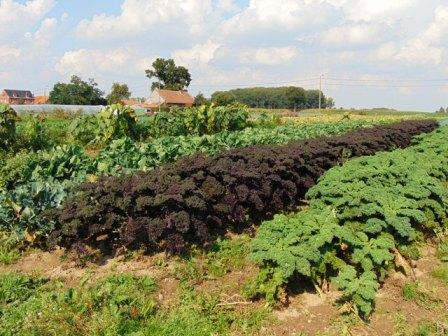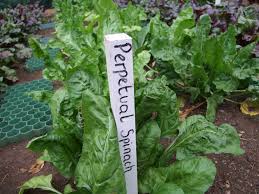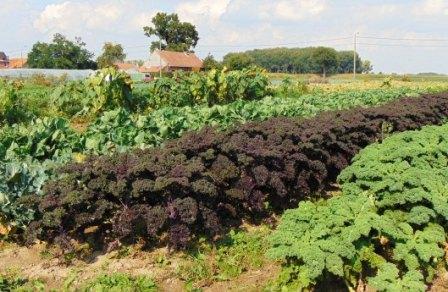Not all edible plants (parts) should as most vegetables be replanted every year in the vegetable garden. You can also set up a kind of ornamental garden with perennials that produce food.
 Shrubs with berries find herein definitely a place: (forest) strawberry, blueberry, gooseberries, currants, grapes, hazelnuts, raspberries, blackberries...
Shrubs with berries find herein definitely a place: (forest) strawberry, blueberry, gooseberries, currants, grapes, hazelnuts, raspberries, blackberries...
An herbal corner is also evident: chives, lemon balm, sage, lovage,...
If you do not always have to sow this does not mean that the plants do not need care. Planting, pruning, mulching, propagation, watering are equally needed.
Less obvious plants can be found at plant fairs, trade fairs, on the internet or in the alternative circuit. Regional designations may be very different.
Good King Henry (Chenopodium Bonus - Henricus, amaranth family (Amaranthaceae)) is closely related to spinach and saltbush (Atriplex). Almost all year round you can pick leafs.
The species is on the Dutch Red List of rare plants and is found in wooded area in Limburg, Holland, Gelderland and Overijssel on labored, moist, highly nitrogen-rich soil around farms, manure heaps and places where is being urinated.
The plant is 15-60 cm tall and blooms short and highly branched from May to August. The green flowers tangle is at the side axes close to each other.
Good King Henry is an ancient vegetable, the plucked leaves can be stored for one day. The young leaves can be eaten like spinach. The young shoots can be used cooked as a kind of asparagus. In Germany it is called Fette Henne, the seeds are used for fattening chickens. The roots are also used to treat cough in sheep.
Bloody Dock (has many names: Wood Dock, Bloodwort, Blood(y) Sorrel (Rhumex sanguineum)) delivers mild acidic leaves to color a salad or use as spinach. The oblong leaves are light green, sometimes with purple red veins. They are rounded to heart-shaped at the base and narrower at the top, 60 to 120 cm high.
This marsh plant is quite common, but is rare in the sandy Kempen (Campine).
Wild chicory (blue sailors, Cichorium intybus) is the original form of chicory. It requires less care and is versatile in use. You can sow very close as for use as (to cut) romaine, thinning to get large plants to bleach or to grow thick roots to force in winter and bleach as Belgian endive (also called Brussels chicory).
Caucasian Spinach (Hablitzia Tamnoides) is an ancient Scandinavian vegetables, originally from the Caucasus. In Sweden, this hardy climbers (up to 3m high.) are cultivated and eaten since 1700. In spring and summer, the leaves are picked and eaten like spinach.
In the spring is rather superficial sow in pots, and the plants are put to their final place after two months.
Turkish rocket (Bunias orientalis) is a perennial, hardy foliage plant with a spicy flavor. Raw and / or bleached useful in spring with yellow edible flower buds and leaves.
Alexanders or Horse parsley, wild celery (Smyrnium olusatrum) is a two-to perennial (remove bloom) whose bleached or young steal and young leaves and roots are eaten. The taste is akin to celery. Sows itself easily. Also be increased by one-year roots.
Lesser Celandine (Ranunculus ficaria) is an ineradicable, water-loving (weed) herb and delivers about the first fruit in the spring. Pluck the leaves that contain much vitamin C before flowering, because then there is toxic saponin in. (The juice formerly should have been used as an arrow poison.)
 The California nettle (Urtica dioica L. subsp.gracilis) is a subspecies of the common nettle, but with very little fire hair, so picking friendly.
The California nettle (Urtica dioica L. subsp.gracilis) is a subspecies of the common nettle, but with very little fire hair, so picking friendly.
Wild fennel (Foeniculum vulgare) is a great host for swallowtail, and is up to 4 meters high. Except during periods of frost you have all year round petals, flower umbels, axillary shoots and (im) mature seeds to harvest.
Many garlic species are perennial suppliers of fresh green.
Welsh onion (Allium fistulosum) is a perennial and hardy stem onion that looks like a kind of giant chives. Grows to 70 cm.
The mountain garlic (Allium lusitanicum) is similar to the Welsh onion. It is a 60 cm high with giant chives or onion pipes with at the bottom a deep red hue. Biennial to perennial.
Wild leek (Allium ampeloprasum var. porrum): you eat most of the year the leek shoots, and in summer the spheres. Propagation you do by planting the balls early September or plants teared between November and April. Grows as garlic, and tastes like leeks.
Elephant Garlic (Allium ampeloprasum var. Ampeloprasum) is a hand large variation.
Crosne is named after the French town of one of the first European farmers.
Jerusalem artichoke is related to the sunflower and easy to grow.
(See <Others tubers> for more info and other species) (Wild) borekale (or cabbage, branching bush kale, has many names: Brassica oleracea var. Acephala or ramosa) never blooms, has constant leaf production and cuttings can throughout the year easy be planted.
(Wild) borekale (or cabbage, branching bush kale, has many names: Brassica oleracea var. Acephala or ramosa) never blooms, has constant leaf production and cuttings can throughout the year easy be planted.
Forms (like kale or curly kale) no head but loose leaves and is hardy (up to -15 degrees). Best provide high plants (up to 1 to 1.5 m) some support. Also used as greens.
Broccoli 'Nine Star Perennial ' is a white broccoli. Grows the first year to a sharp leaf cabbage, and will produce 6-16 mini cauliflowers in the leaf axils during the spring of the second and subsequent years. You should harvest all the creamy white buttons, otherwise, the plant produces seed and she dies. The coals are edible raw or cooked. The leaves are also edible.
Sea kale (Crambe maritima) loves salty soil and is decorative. Moisty sowing from March to April in trays. The roots are especially from the 3rd year running strongly. You can cover the young shoots under a pot or bucket to bleach as asparagus.
There are two types of asparagus: white, growing in the earth in high beds (to prevent discoloration) and green that grow above the ground. Asparagus is a perennial plant, which is successively 8 to 10 years grown on the same field. Green asparagus are fragrant and have a stronger flavor than white. You can harvest more and they don’t need to be peeled.
The cutting of (white) asparagus (spears) occurs from late April to the feast day of Saint John on June 24.
Green asparagus (e.g. Mary Washington) you can sow thinly in rows in March and let them several years to develop. (Seed soaking one week in water, 3 weeks germ time.) After two years you can reap by snapping the aboveground green stems.
Cut the hard woody portion of the bottom, and optionally only peel the lower part. Prepare asparagus of equal thickness, which have the same cooking time.
White asparagus (Ex. Argenteuil) you can sow in the spring and the young claws after a year plant them 20 cm deep, 40 cm apart. In spring ridging and bleaching. Harvest from the third year.
Artichoke is a decorative plant whose fleshy bracts of the closed flower buds are eaten as a vegetable. The harvest of the still closed flower buds happens in August and September. After the harvest, the flower stalk is cut from the plant.
In winter, should she be frost covered with straw and plastic, or excavated, the roots to overwinter in the basement and early March planted out again.
The normal (and best) way to multiply is with root cuttings (shoots with roots) or sowing in March or early April under glass.
Oyster leaf (or –plant, Mertensia maritima) is a pretty solid coast of Scotland plant with gray-green leaves and small sky-blue flowers. The juicy, edible leaves have a slightly salty oyster taste and can be used raw. Sew or devision early in the spring.
Samphire or sea fennel (Chritmum maritimum) leaves, flowers and seeds pickled or fresh used as a seasoning ..
Rhubarb needs little care and produces each year (quite early) a hefty harvest. Rheum rhabarbarum requires a sunny place, can also partial shade. The shrub can muster sheet steal several years. He needed that fertile land is not flooded in the winter. There are varieties with red and green steal steal. By cutting off stems the remaining pieces can rot. Bend and pull the handle loose, and cut the leaves off. Cut the leaves straight away, because otherwise much moisture might escape to the leaf. The truss-shaped branched inflorescence is usually taken away, for the benefit of the edible sheet steal. The oxalic acid is poisonous if you do a lot (about 10 kilos) of eating. Oxalic acid displaces calcium absorption in the body, thus restricting the use to 2 times / week.
Was from the root and still extract a strong laxative. Rhubarb also would like abrasives for pots and pans, as hair dye or as to its use insecticide. By its oxalic acid rhubarb has few predators.
For propagation, you can easily divide the rhizome.
For outdoor cultivation is recommended (April to 21 June) after the longest day not steal to harvest more, so the plant can store sufficient spare components for the next year. Oxalic acid later moves from the leaves to the stem. Later the stems will be tougher and contain more oxalic acid. Young stems contain less oxalic acid. Let stand still steal a three-tal.
For the forcing cultivation are one to three years old pollen in the winter darkness aside. You can also after a period of frost the outside bush which force by covering him with a bucket filled with hay.
The word rhubarb came through the Reon Barbarikon Greek into Latin. Rha was referring to the Volga. In the word Rhaponticum Pontus refers to a region on the Black Sea. In barber you still hear the distant, foreign or barbaric origins.
Some find blanched rhubarb, also called 'champagne rhubarb', a real delicacy.
The Rhubarb Triangle (23 km2 West Yorkshire, England) is famous for the production of early forced rhubarb.
After 2 (to 3) years on heavily fertilized fields the roots with soil are harvested. The roots are exposed first few days to weeks to frost before they are put in November in complete darkness in heated hangars. The plants begin to grow by the heat. The in the roots stored carbohydrates are converted into glucose. This gives a bittersweet taste to forced rhubarb.
Traditionally they are harvested by candlelight in order to not stop the growth. In late March, the harvest is over and the rhizome exhausted. He can be replanted.
Before World War II were uniformly bright pink stalks from Christmas to Easter highly sought after in London and Paris. They are much less acidic than non-forced rhubarb.
To bleach and force there are also large terracotta forcing pot with a lid.
"If you eat natural foods you will die a natural death." (Robert H. Smith)
Asparagus makes your pee smell funny. And vice versa.
